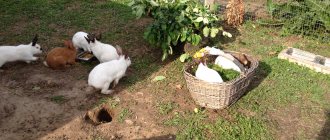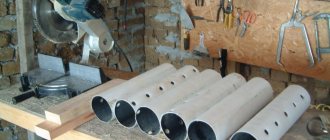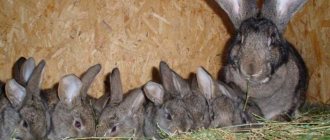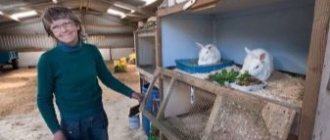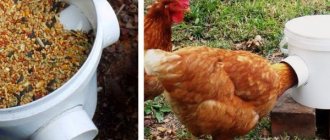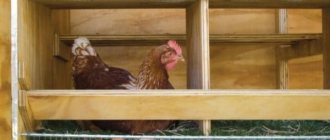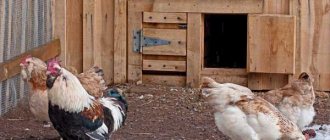Requirements for drinking bowls
Beginning rabbit breeders use ordinary bowls or other available containers for drinking, while neglecting the basic rules of hygiene and convenience. This can have a negative impact on your pet's health.
It is important that when choosing a drinking bowl the following requirements are met:
- the container must hold a large volume of water (the daily norm is equal to 1 liter per individual);
- be well protected from dirt, dust and germs;
- convenient for filling;
- with good fastenings so that animals cannot tip over.
Ideas for drinking bowls for rabbits, photo gallery:
conclusions
- Water is one of the main sources of life for any animal.
- Automatic systems make caring for rabbits easier, especially if there are a large number of them.
- Nipple drinkers, like winter heated ones, can be bought ready-made or made yourself from improvised materials. However, it is preferable to buy the nipple tip itself ready-made.
- An automatic drinker significantly saves time and money on keeping animals.
- The nipple system has a number of disadvantages, but in farms with a large number of animals it is irreplaceable.
- Rabbits very quickly learn to use the automatic water supply system.
Types of drinking bowls for rabbits
There are 5 different types of sippy cups. Each of them has its own advantages and disadvantages. When choosing, rabbit breeders are based on:
- convenience;
- practicality;
- cost.
| View | Advantages | Flaws |
| Cup - a container filled with water. | No cost required. | It is not airtight, requires constant water changes, the animal may tip over or relieve itself. |
| Vacuum - the bottle is filled with water and placed on a container with the neck down; when the water in the bowl runs out, a new portion is poured. | Easy to make, the bottle protects the liquid from debris. | Dirt can get into the bowl, it can easily be knocked over, and it freezes in winter. |
| Nipple - the animal touches the nipple with the tip of its tongue and the liquid flows through the tube to it. | You can make it yourself, it doesn’t get dirty, it doesn’t spill, and the water level is visible. | Not suitable for winter outdoor use. |
| Automatic - used in large-scale breeding, the tank is filled with fresh water and a valve-regulator is installed, tubes are connected to the bowls in the cages to supply liquid. | Reduces time spent on maintenance, prevents contamination, and provides water to entire livestock. | Ready-made ones are expensive, making them yourself is difficult and financially costly. |
| Bottled - used for keeping decorative breeds at home; their structure is similar to nipple ones. | Access to clean drinking water around the clock. | Requires time and money to make. |
Main disadvantages
A nipple drinker for rabbits is inconvenient in cases where the animal is sick. It is difficult for him to move and get water by pressing the ball. The system is dangerous during epidemics: direct contact with the tube leads to the rapid spread of the disease.
A significant drawback of the system is freezing in winter. It is impossible to completely insulate and isolate the cage from low temperatures, so the open part of the container may freeze, which complicates watering the animals. The lower the temperature outside, the lower the water temperature - because of the cold liquid, rabbits can often get sick.
Additionally, fasteners and tubes are purchased, which have to be changed frequently. Spending on such devices is one of the disadvantages of a nipple drinker. It is difficult to adjust one device for individuals of different species and sizes. It is necessary to install several containers at once so that the rabbits do not suffer from a lack of liquid.
Instructions for making drinking bowls yourself
Making a sippy cup with your own hands will be much cheaper than buying it in a store. In your own production, you can take into account all the nuances so that both the breeder and the animals feel comfortable.
Nipple
To make a sippy cup you will need:
- medium-sized plastic bottle;
- fastenings or wire;
- a special nipple attachment (can be purchased at pet supply stores);
- screw cap (choose so that the diameter matches the bottom);
- jigsaw
The bottle is turned over and the bottom is cut off. Close it with a lid. If its diameter is not suitable, then the cut-off bottom is attached to the bottle using adhesive tape or tape, and used as a hinged lid. The purchased nozzle is screwed onto the neck. They are secured to the wall of the cage using special plastic fasteners or tightly wrapped with wire. Then fill with water.
Nipple drinker drawings:
Cup
For this type, select a container made of plastic or iron (enamel). The diameter per individual is 15-20 cm, and the height of the walls is no more than 3-4 cm. To give the bowl stability, a weight is attached to the bottom. Then the rabbit will not be able to knock it over with its paws if it leads an active lifestyle.
The second option is to attach a bowl of water to the wall of the cage. Holes are drilled in the sides through which the wire is threaded and tightly wound. The sippy cup is ready. It should be remembered that it requires changing the water and cleaning it from dirt several times a day.
Vacuum
No cost required. The easiest way to ensure that your animal always has clean drinking water. For production you will need:
- plastic bottle;
- clamps or wire for fastening.
The pre-filled container is turned upside down and placed close to the bottom of the bowl. The bottle itself is attached tightly to the wall with clamps or wire. When the water runs out, the container is washed and refilled. In such drinking bowls, the animals receive clean drinking water; the level in the reservoir is always visible in order to replenish the supply in time.
Drip
Such a drinking bowl is very easy, quick and cheap to make. You will need a plastic bottle, for example, with a capacity of 1.5 liters, glue, a screw and a plastic case from a ballpoint pen.
The plastic bottle must be empty and closed with a cap with a pre-drilled hole for the straw.
The tube is a body from a ballpoint pen, into which, instead of an ink cylinder, a screw of a suitable diameter is inserted - it should be of such a size as to fit the hole for the ballpoint refill.
The design of the bottle and plastic case is ready. Using a glue gun, it is firmly fixed in the lid. A hole is cut in the container itself, closer to the bottom, for filling with water. You can simply cut off the bottom and replace it with a snap-on, tight-fitting lid. Once assembled, the homemade drinking bowl is installed in a cage, for example, in a special clamp. The result is a device that resembles a drip washbasin in its operating principle.
In the same way, you can make a feeder and secure both bottles side by side. Larger containers can be purchased.
This design, combining a drinker and a feeder, guarantees cleanliness in the cage - water will not spill and food will not spill, therefore, cleanliness and the absence of puddles are guaranteed in the rabbits’ home.
You just need to regularly wash the containers, fill them with clean water, and add small feed.
Required materials
When giving preference to one material or another when making your own drinking bowl, you need to clearly determine the number of rabbits that will inhabit the farm.
For small farms, cup drinkers with bowls as reservoirs would be a completely suitable option. They may use a drip mechanism or more advanced systems.
You can correctly resolve the issue of rabbits being able to turn over containers of drink in different ways: use wire, a plastic bottle holder, or any other fasteners that can serve well as various household items.
More experienced breeders often use metal sheets or PVC plates. The above materials, of course, are available for purchase in specialized stores, but when creating a drinking bowl with your own hands, you want to save money.
Therefore, do not hesitate to use any materials that are unnecessary on the farm, if they can be suitable for creating the design of a drinking bowl.
An entrepreneur who decides to start breeding rabbits and make drinking bowls for rabbits with his own hands should know that the ability to save on such seemingly small points can significantly reduce the amount of expenses. In addition, experienced breeders have developed schemes.
They will help you quickly and efficiently build drinking bowls. These schemes are suitable even when it comes to hanging structures.
How to accustom a rabbit to a drinking bowl
Teaching your rabbit to drink from a sippy cup takes time and care. One awkward movement can ruin all your efforts if the animal gets scared. Almost all drinking bowls contain bowls in their design; rabbits will drink from them on their own. Only the nipple ones do not include a bowl for supplying liquid.
To train an animal, you can:
- temporarily loosen the nipple so that water drips from it into the placed dish;
- carefully pick up a well-fed animal and bring it to the drinking bowl, press the valve with your finger so that he can see the water drip and apply it to the spout, return the animal to the cage and monitor the process, repeat if necessary until the rabbit learns to drink on its own.
Advantages and disadvantages
Like any thing, an automatic drinker has its pros and cons.
Pros:
- Water, being in a closed container, remains clean for a long time.
- Fluid consumption is significantly reduced because it cannot evaporate.
- Water spillage is almost impossible. Therefore, the bedding remains dry, preventing foot diseases in rabbits.
- Nipple drinkers are indispensable if it is necessary to give vitamins or medications to all animals at the same time.
Minuses:
- At low temperatures, the water in them freezes.
- Most often, the containers of such drinkers have a small volume.
- With constant addition of water, the lids wear out and begin to leak.
- High cost of ready-made drinkers.
Despite the high cost of this product, it has a huge number of advantages.


